What is a print exchange?
A portfolio exchange or print exchange is a printmaking tradition that speaks to the medium’s democratic and collaborative nature. Participating artists agree to create an edition large enough to supply one print for each participant and sometimes extras for print collections like the WFMA. Exchange coordinators then collate the prints together into a box or portfolio creating a set of prints that each artist receives. Print exchanges connect artists and expands the number of venues the exchange can be exhibited.
Participating Artists:
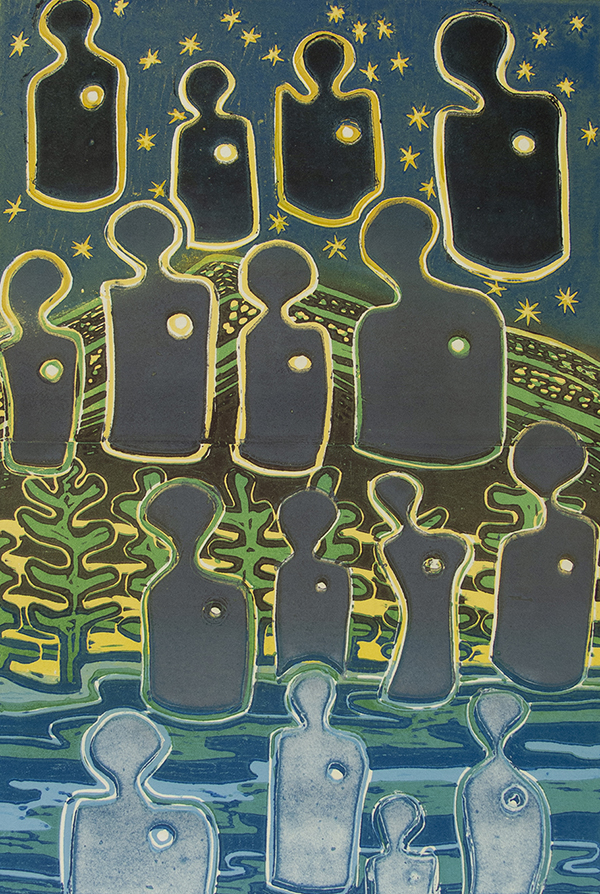
Maile Andrade- Kilauea, Hawaii, USA
Ascending, 2020
Relief print
Maile Andrade is a multi-media artist and has a Master of Fine Arts degree from the University of Hawai'i-Månoa. She presently is a Professor at Kamakakukalani Center for Hawaiian Studies at the University of Hawai'i-Manoa teaching in a Native Hawaiian Creative Expression Program.
She has received a variety of academic awards and was selected by the Folk Arts Apprentice Program to serve as an apprentice with Master Weaver Elizabeth Lee and received the 1998 Visual Arts Fellowship from the State Foundation on Culture and the Arts.
She has participated in several Indigenous Symposiums/Gatherings in New Zealand, Tahiti, and the Longhouse in Evergreen State College, Washington. Maile was artist-in-resident in New Zealand, at the Alaska Heritage Center, Anchorage, and SAR School for Advanced Research, Santa Fe, NM. She serves as an Affiliated Researcher at Bishop Museum and has presented all over the world. She has exhibited her works locally, nationally, and internationally.
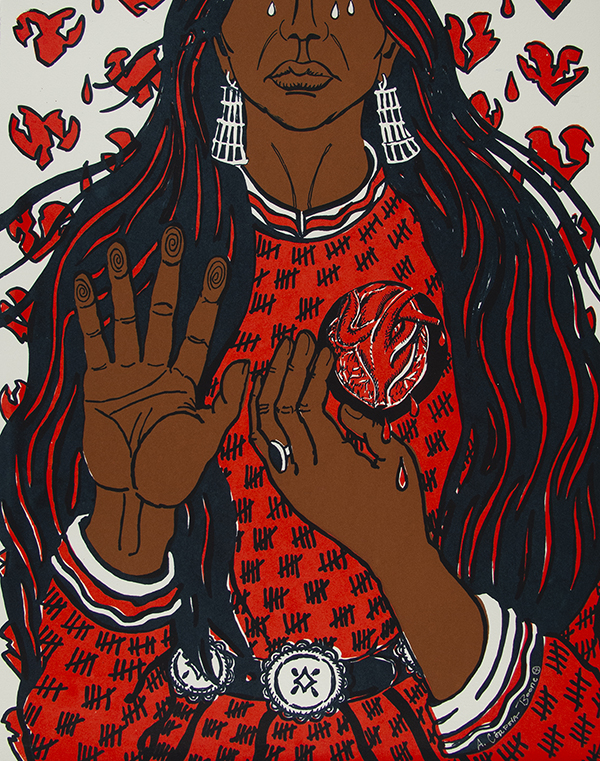
Amy Córdova- Oaxaca, Mexico, USA
How Many Broken Hearts?, 2020
Screenprint
Amy Córdova Boone began her professional art career in the late 1980s with representation by Elaine Horwich, and her historic Santa Fe gallery. As well as exhibiting vibrant, colorful works of art rooted in the interconnectedness of humans and the world we share, Córdova Boone has served as an arts educator and place-based curriculum designer for more than thirty years. Córdova Boone has actively participated as an “artist in residence” in schools, libraries, and universities throughout the U.S. She is honored to have conducted art and creativity workshops for the University of Minnesota and the University of Nebraska Roots Program, where she shared hands-on art and heart workshops with many inspiring Indigenous educators.
Córdova Boone has shared her many-colored vision throughout the United States for the NEA Big Read Program and spoke at the Heard Museum regarding her book art which was included in a Heard exhibit. She won the ALA Pura Belpre Honors twice, a national award for authentic depictions within a cultural context, with regard to children's literature. With more than twenty illustrated, published works for others and two titles of her own, Córdova Boone continues to feed her love of the hoop... through art and word. Currently, she lives in a small village outside of Oaxaca, Mexico with her artist husband, Steven Boone.
The piece I created for this powerful and much-needed collaboration is entitled, "HOW MANY BROKEN HEARTS?" We will never see the eyes of these missing sisters, women, and girls ever again. Many are forgotten, not by families, but by society in general....those unknown, those statistics. The design on her garment is a representation of a "count" of those who have disappeared. The broken hearts speak for themselves.
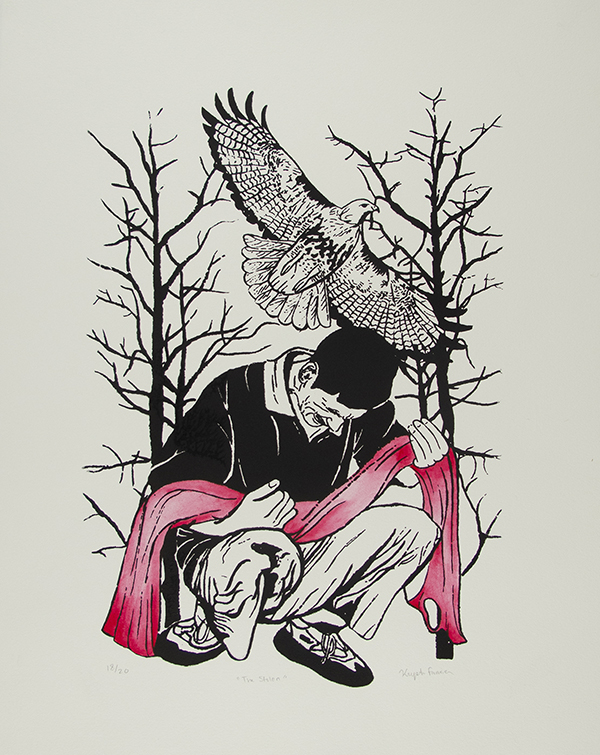
Krysten Farrier- Wichita Falls, Texas, USA
The Stolen, 2020
Screenprint
Krysten Farrier is a graphic designer and printmaker that currently resides in Wichita Falls, Texas. She graduated from Midwestern State University with a Bachelor in Fine Arts with an emphasis in Graphic Design and a secondary emphasis in Printmaking in the fall of 2018. Her work is an examination of different design strategies she uses to create challenging pieces of work on worldwide events and social movements.
She works with a combination of media that can include serigraphs, digital prints, traffic signs, or newspaper clippings in an effort to advance social change through empathy and empowerment. Her goal is to challenge the status quo by pushing the boundaries of public opinion, leading it to greater knowledge and empathy.
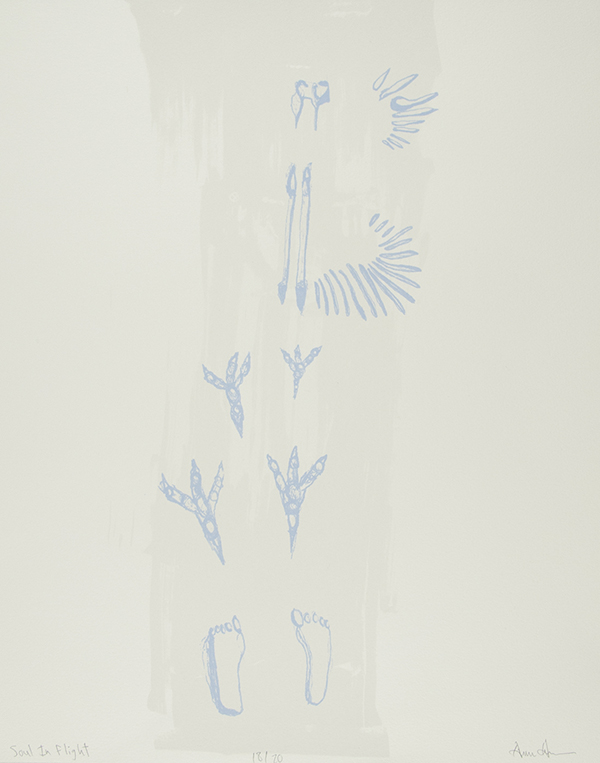
Anna Hoover- Anchorage, Alaska, USA
Soul in Flight, 2021
Screenprint
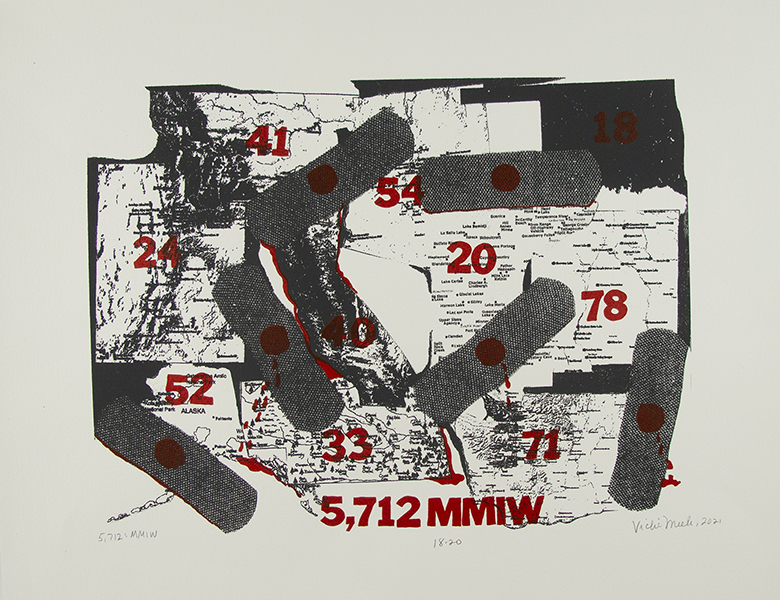
Vicki Meek-Dallas, Texas, USA
America Cares More about Parks than MMIW, 2021
Screenprint
Vicki Meek has exhibited widely and is in the permanent collections of the African American Museum Dallas, Fort Wayne Museum of Art, and Museum of Fine Arts Houston. She was awarded three public arts commissions with Dallas Area Rapid Transit Art Program, private commissions with Nasher Sculpture Center, and was co-artist on the largest public art project in Dallas, the Dallas Convention Center Public Art Project. Vicki Meek resides in Dallas TX where she is also an independent curator and writes cultural criticism.
My print entitled "America Cares More About Parks than MMIW" illustrates the 2016 census numbers on the reported missing or murdered indigenous women and the states with the largest unsolved reported cases. The fact that this number reflects statistics from nearly 5 years ago means the total is likely much higher, especially since it's also a fact that many of the women missing never make the police caseload. My print uses maps of these states and their national parks as a metaphor for how America values the health and welfare of its parks but cannot muster the same level of concern for indigenous women. The 5,712 figure exceeds by nearly double the number of lives lost in the 9/11 attack, an event that most Americans will never forget and one that our government uses as a reminder harm was done to us as a nation.
Yet the plight of our indigenous women who suffer, in disproportionate numbers, the fate of being murdered doesn't raise an alarm for either our government or the average American. As a woman, especially as a Black woman, I understand being cast aside and think all of us women should be willing to stand up and demand that more be done to address this crisis. A mere bandaid approach to this problem will only result in a continued blood bath in the Native American community.
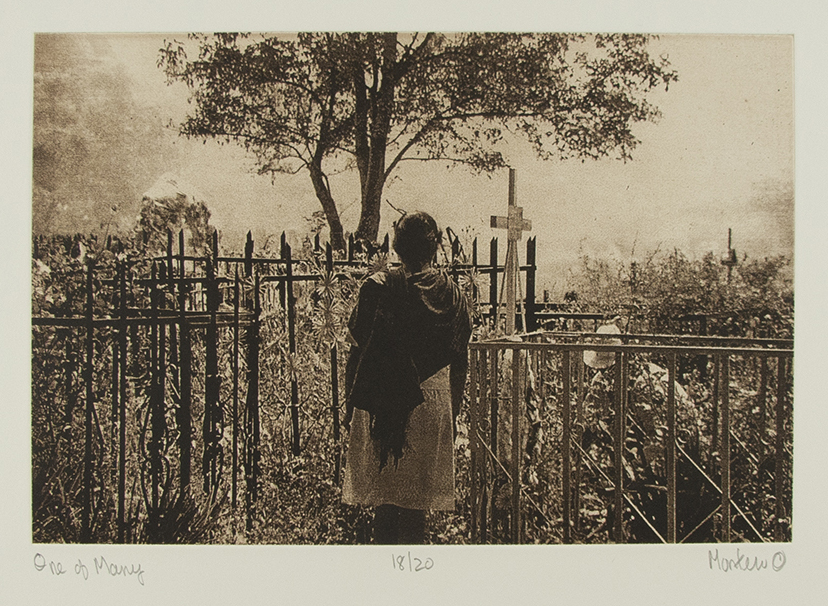
Sylvia Montero- Denver, Colorado, USA
One of Many, 2020
Intaglio
I am a visual artist, printer, and photographer. I am an artist who is dedicated to social issues. In 2016, I was drawn by a physical, subconscious force to look into this deadly issue of missing, indigenous, Women. I began researching the missing extensively, specifically in the United States. The missing of our indigenous women began when they landed on our shores.
The print I have chosen for this print exchange is titled One of Many. I consider this image to be a universal image of death. Looking at the image, we can briefly remember someone we have lost. Connecting us all. Currently, I am creating a body of artwork which speaks of the missing. I have begun weeping while working on this series, I have come to terms that the tears are of the dead, tears of their families, tears of their pets and friends, my tears. I like to believe that they are healing tears. I like to believe that the women, spirits of the missing are my mothers watching over me. Reminding me to speak of them in my art.
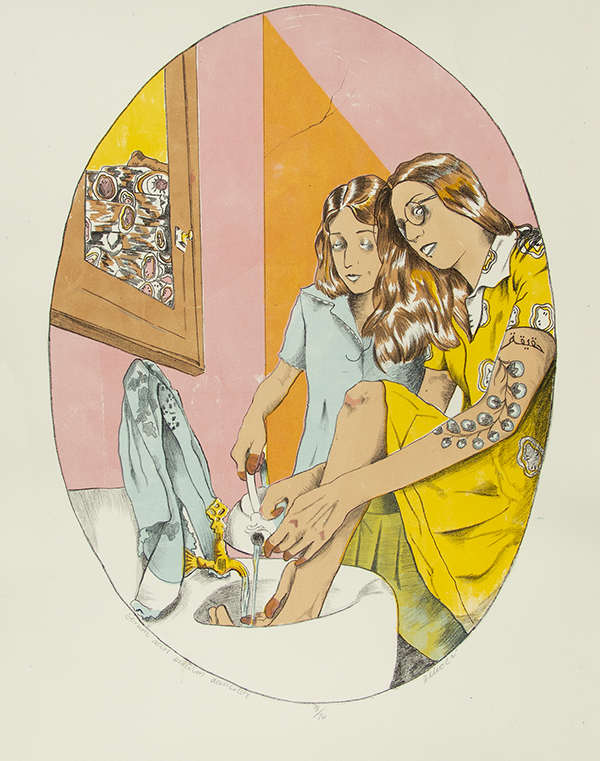
Dilara Miller-Boulder, Colorado, USA & Mersin, Turkey
Senin Acin Benim Acimdir (Your Pain is my Pain), 2020
Lithography and screenprint
Dilara Miller is an artist based between Mersin, Turkey and Boulder, Colorado who is a BFA candidate at the University of Colorado Boulder. Dilara's work critiques and reflects on the social/cultural effects of being Turkish/American as well as being a woman in Turkish society. Her work uses her family's history, the regional traditions, surrounding history, and religion to narrate these themes through created symbols.
Senin Acin Benim Acimdir (Your Pain is my Pain) depicts a cleansing ritual named Abdest (Abolution), this ritual is done before every Namaz (daily prayer). Growing up devout I performed this ritual constantly and my mother still continues today often leaving the traces of puddles on the floor. Through this ritual, I wanted to reimagine my experiences of growing up in a predominantly Islamic surroundings and to express the innate kinship, community, and warmth I feel around women. Within this work, the use of logs depicts a natural fuel that can be scared from its collection and then later burned to ash, a cycle I wanted to depict of one's experience of trauma and a cleansing through sisterly support within a traditional setting. I believe as women we all experience tribulations within our lives that are symptomatic of our surroundings, though I trust we often hold an innate connection. A saying my mother often said to me when I was in pain, "I wish your pain was my pain", and I feel that way for the women who experience the hardships life has to offer historically and presently.
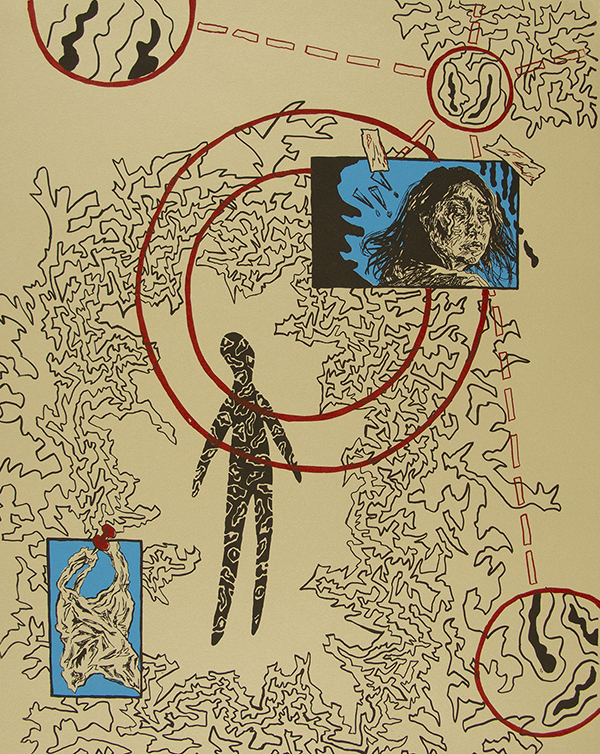
Andi Newberry-Wichita Falls, Texas, USA
Probable Fear, 2021
Screenprint
Andi Newberry is a third-year undergraduate student pursuing a Bachelor of Fine Arts at Midwestern State University in Wichita Falls, Texas. She creates work using printmaking, drawing, painting, clay, and mixed media. Her work explores the intrinsic connection between the artist's identity and the physical artwork, which emerges as a result of time spent with the work. Newberry draws upon childhood experiences, familial relationships, and intimacy with the self, others, the public, and the voyeur.
Probable Fear illustrates my personal dealings with a haunting feeling of inevitability regarding violence towards my body and my personhood. As I've grown, the realities of sexual assault forcibly made themselves clear. I've discovered that more and more of my close friends have dealt with these experiences. Sexual assault and violence began to feel like an ever-present, unstoppable threat, affecting the ones I love and slowly closing in on me. This piece depicts the resulting feelings of fear and defensiveness, with areas of magnification to reflect the groups of women that deal with much higher rates of violence inflicted upon them. Probable Fear includes elements of collage and automatic drawing, along with inspiration from pulp horror-fiction novel covers.
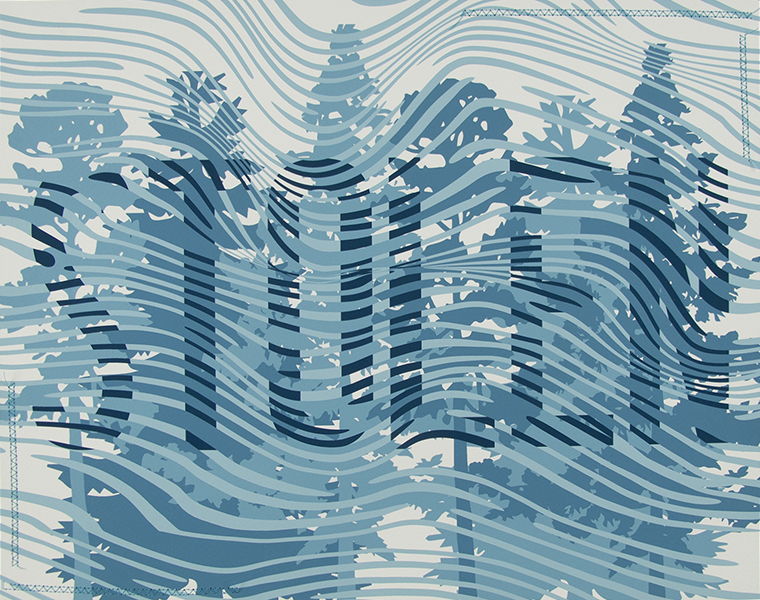
Morgan Page- Wichita Falls, Texas, USA
Stolen, 2021
Digital archival print and thread
Morgan Page is an artist, designer, and Associate Professor of Art at Midwestern State University in Wichita Falls, Texas. Page received a Bachelor of Fine Art from the University of Houston in Houston, Texas, and a Masters of Fine Art from Rutgers University, Mason Gross School of the Arts in New Brunswick, New Jersey. Page exhibits work nationally and internationally. Recent exhibitions include Bones of Texas at the Museum of North Texas History in Wichita Falls, Texas, Capas at Marshall Arts Gallery in Memphis, Tennessee, and Foreign Affairs Game Show at the Universidad del Claustro de Sor Juana in Mexico City, Mexico.
Page is a cross-disciplinary artist working in digital illustration, textiles, photography, performance, and installation. She also regularly publishes exhibition reviews and art-related research in journals and books. Her work is often art-based research in topics that include immigration, cultural lineage, and abandoned pioneer towns.
Stolen is a digital illustration printed on archival cold press paper with archival pigments. After printing, each image has been sewn into at the corners. These are varied editions as each length of thread is slightly different each time. This image was inspired by the Stolen podcast written and produced by Canadian Journalist Connie Walker. These prints are dedicated to Jermain Charlo, who has been missing since 2018 and is presumed deceased. The term stolen can certainly speak to all that has been stolen from Indigenous people throughout time.
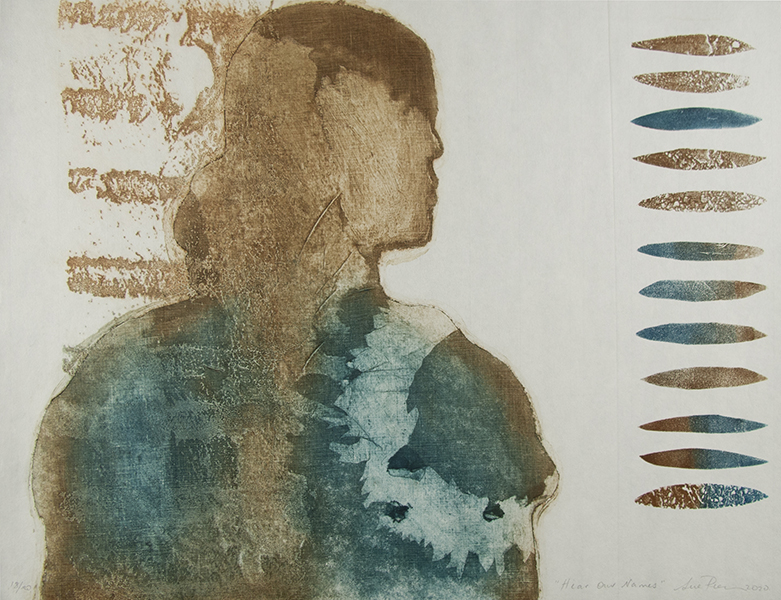
Sue Pearson- Whakatane, New Zealand
Hear Our Names, 2020
Collagraph on mulberry paper
Excerpt from Gaye Evans's speech at the 1st Heiva, Norfolk Island in January 2020.
MAUATUA TERAURA WAHINEATUA TOOFAITITEVARUA TEIO OPUARAI FAAHOTU TEATUAHITIAA TEEHUTEATUAONOA T INAFANAEA MAREVA
Orlem gehl tek lornafe dem, de thing dem bin lern from dems madha
TIINA FANIIA'S salan miek a byuuteful clorth. Se gliez et soe kaa wet wen rien en giw orf wan swiit smael simmes wan flauwa
TOH U FA IITI from Huahine. Dem miek a byuuteful klorth
TERAURA miek a brait 'ahu se dekariet et
MAUATUA miek a fain san bliich klorth
Sam a dem tek a tuuls lorngfe dem ornaa shep; thing fe miek a 'ahu, en a aute shuut ena katen se raep et ap guud soe el plant et wen dem get wesaid dem gwen.
En wen dem get deya, dem planta yaam ena tieti; yolo de pilahai; rig a rohd fe ketch a fish.
Lorngfe dems tools; dem thing fe plant dem bring lorngfe dem; en dems noewen, dem miek dems nyuu laif. En dem staat auwas.
Se rait et ina buk that domain weside yu goe orn Pitcairn, yu el ya dem gehl.
Singen, daansen, kuken, nersen, berthen, chaanten, wiiwen, lauwen, faiten, klaiyen, planten, pienten, prieyen, diyeden en lewen.
En de saun a dem biiten. Biiten autem taapa. En hetieh aklan.
In January 2020 Norfolk Islanders held their first Heiva. In her opening speech, Gaye Evans of the Council of Elders honoured and dedicated the event to our Polynesian foremothers, the women who left their homes and families forever and traveled on the Bounty settling Pitcairn Island. Gaye named each of the 12 women who were founders of the Pitcairn and Norfolk Island people and spoke to their enormous contributions, strengths, and refined skills. This was the first Norfolk Island community event that I have witnessed dedicated to our ancestresses, their names pronounced correctly. With a history long observed, written, and presented through a Eurocentric male lens, these women had all but disappeared from view with their male counterparts, mutineers of the Bounty and the male leaders of the Pitcairn community receiving accolades and exclusive focus. This print is about the reappearing of our grandmothers in our communal identity and their names upon our tongues.
Sue Pearson Bio Sue Pearson is a and descendant of the mutineers of the HMS Bounty and the Polynesian women who settled on Pitcairn Island in the 18th Century, and later Norfolk Island. Sue grew up on Norfolk Island and though she now lives most of the year in New Zealand she maintains strong ties with her home, family, and land. Sue has a BA Visual Arts at Newcastle University, Australia 1986, and has continued a fine art practice exhibiting internationally ever since. Pearson's interpretations of her personal heritage, narratives, and ideas are at sometimes easily accessible and at other times personally coded or in a visual language understood by Norfolk Islanders. Pearson creates works that share the stories of her life, thoughts, home, and heritage and provide vehicles for connections on a range of levels of experience. Sue is deeply inspired by the patience, innovation, practicality, and creativity of her Tahitian foremothers who were great tapa cloth (bark cloth) makers and printers, and the joining spaces that have formed through the sharing of work, stories, and life with others.
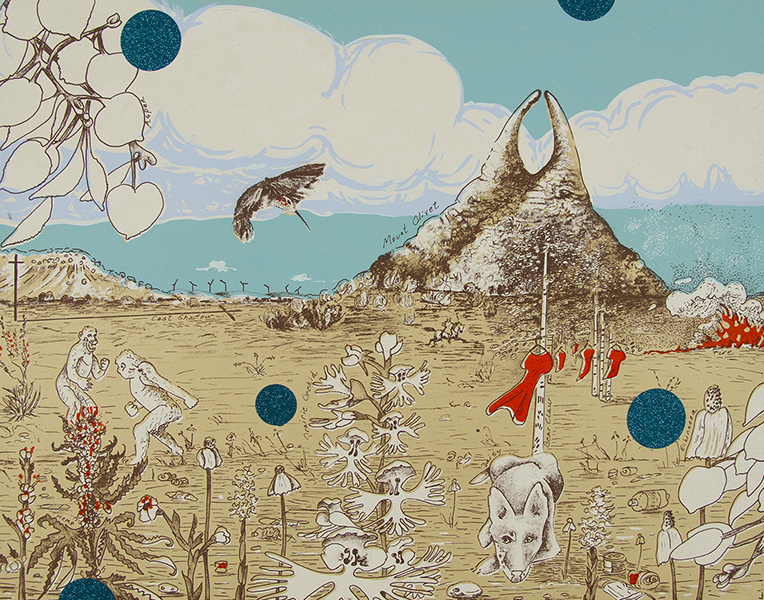
Catherine Prose- Wichita Falls, Texas, USA
Daisy Protecting Our Indigenous Sisters, 2021
Screenprint and vinyl
Catherine Prose is an artist working as Professor of Art at Midwestern State University in Wichita Falls Texas. Prose holds a Bachelor of Art from Cameron University, Lawton, Oklahoma and a Masters of Fine Art from Texas Tech University, Lubbock, Texas. Prose's artwork has been exhibited extensively nationally and internationally in both group and solo showings. Her artwork is in the collections of the National Gallery of Australia, Colorado Special Collections, Boulder, Colorado, and in the Printmaker Research Collection at the Museum of Texas Tech University in Lubbock, Texas.
Prose's artwork reflects her advocacy for the conservation of nature and explores ideas about landscape, the environment, and how religion can play a role in the way people might value nature and women.
One of my deepest darkest worries in life is having a loved one die in fear and under the hand of hate. This is the thought I keep coming back to while reading, learning, and understanding how federal laws; colonial laws, limit Tribal protections of women. These women, all of them, had their last experience on Earth in fear. And there is over five hundred years of layered infrastructure that contributed and continues to contribute to these fearful deaths.
Daisy Protecting Our Indigenous Sisters
Birds unify heaven and earth; hummingbirds bring love, joy, and healing
Blue is our tears and blue is the water that cleans our wounds
Red dresses symbolize Jaime Black's expression of grief we all share
Pointing to religion overshadowing everything and primordial man fighting
I give you my mother's handwriting, faithfully strong-willed
I give you a fierce bear claw, deliberate in action
I give you the medicine and playfulness of a Quaking Aspen
I give you my companion, Daisy to keep watch and to warn you of danger
"Bad people commit these horrible crimes against Native women, but it is the system that allows it to happen generation after generation.”—Malinda Limberhand, mother of Hanna Harris who was murdered in 2013 on the Northern Cheyenne Reservation.
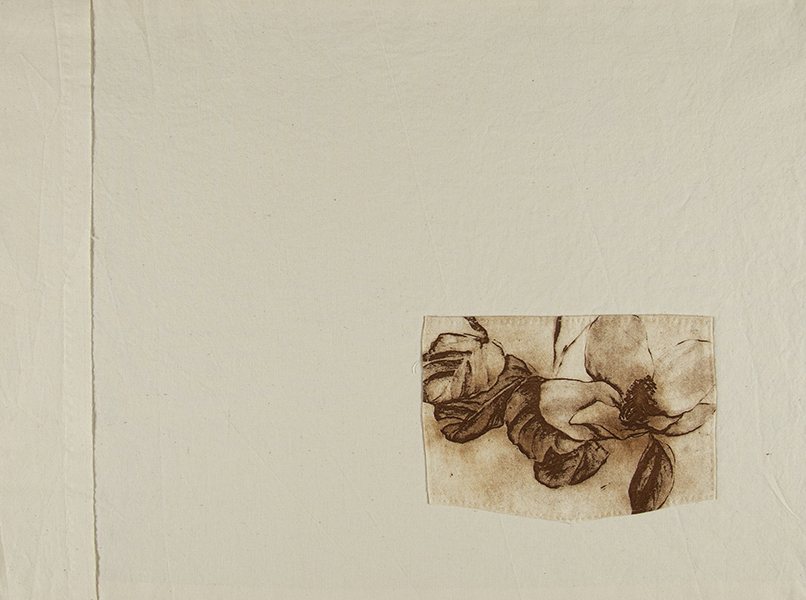
Rebecca Ramos- Aptos, California, USA
Pocket Full of Dreams, 2020
Hand sewn muslin pillow case and intaglio
Rebecca Ramos received her Bachelor of Fine Arts from the California College of Arts and Crafts in Oakland, and her Masters of Fine Arts from the University of Colorado, Boulder. Born in Alaska and raised in Hawaii, her father from the Philippines and her mother from Hungary, she has always worked with themes of belonging, storytelling, and identity in her imagery. She teaches drawing and printmaking for Cabrillo College and currently lives in Aptos, California.
Pocket Full of Dreams is about
rest
and gentleness,
a pillowed cradle for the head,
a soft touch for the cheek.
Pocket Full of Dreams is about
protection
and respect
a blossom guardian from the forest,
a sanctuary space to enter and retreat.
Pocket Full of Dreams is about
having each
a sister,
pulled from the same plate,
together sharing the stories that we keep.
The stories that we keep,
the stories that we sleep,
for now and forever
in the pockets of our dreams.
Pocket Full of Dreams is about
a story
and an end,
for a final hope to rest,
for a further peace
and gentleness.
"Pocket Full of Dreams" is a hand-sewn muslin pillowcase, printed with a copper photo etching of Koki'o Ke'oke'o, which is endangered and endemic to Hawaii. The copper plate had 2 renditions of the blossom on it, one photographed and one drawn. Printed simultaneously then cut into singles, each pocket-print has a 'sister' in the edition.
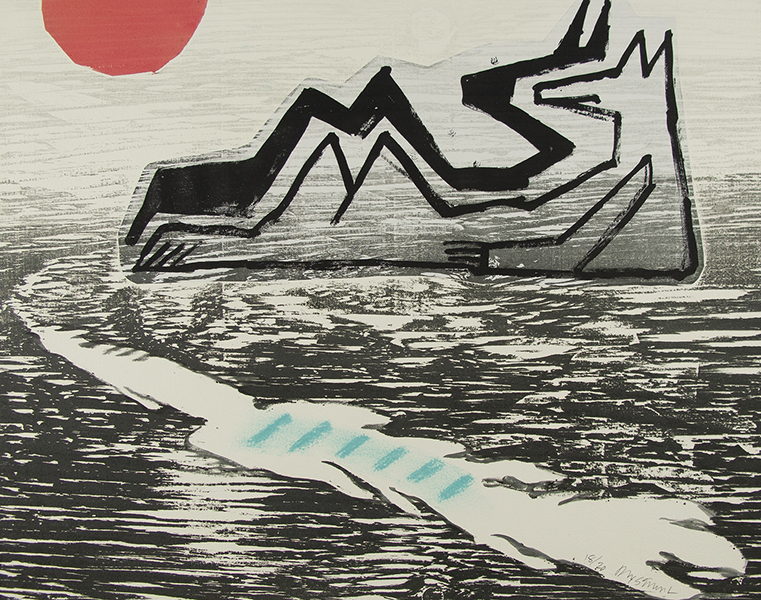
Jaune Quick-to-See-Smith- Corrales, New Mexico, USA
Shadows Across the Land, 2020
Woodblock, chine colle and template
Jaune Quick-to-See Smith calls herself a cultural arts worker. She uses humor and satire to examine myths, stereotypes, and the paradox of American Indian life in contrast to the consumerism of American society. Her work is philosophically centered by her strong traditional beliefs and political activism. Smith is internationally known as an artist, curator, lecturer, printmaker, and free-lance professor as well as a mentor for she believes that Giving Back is a life philosophy.
She was born at St. Ignatius Mission, raised by her father who was an illiterate horse trader, she had her social security card at age eight when she started work as a field hand year-round, she worked as a waitress and in the canneries through high school. Smith earned an Art Ed degree at Framingham State, MA (now University) and a Master's in art at the University of NM. Before completing her degree, Smith began exhibiting in NY at the Kornblee Gallery and organizing Native exhibitions. Smith organized and curated over thirty Native exhibitions in 40 plus years. Smith has given over 200 lectures at museums and universities internationally and has shown in over 125 solo exhibits and over 650 group exhibits.
Her work is in collections such as Victoria and Albert Museum, London; the Brooklyn Museum; the Museum of Modern Art, Quito Ecuador; the Whitney Museum NY; the Walker, Berlin Museum of Ethnology, Germany; University of Regina, Canada; the Museum of Modern Art in NY. Smith holds 5 honorary degrees and numerous awards such as: 1987 Academy of Art and Letters, Purchase Award, NY;1995 Painting Award, Fourth International Bienal, Cuenca, Ecuador S.A.; 1996 Joan Mitchell Foundation Award; 1997 Women's Caucus for Art, Lifetime Achievement; 2005 New Mexico Governor's Award; 2011 Inducted into the National Academy of Design; 2012 Georgia O'Keeffe Museum, Living Artist of Distinction; Honorary BA Degree, Salish Kootenai College, MT; 2018 Montana Governor's Award; 2018 Lifetime Achievement Award in Printmaking, Southern Graphics Council International; 2019 Murray Reich Award, NY; 2020 United States Artists Fellowship.
Shadows Across the Land
The year of Covid has brought changes to everyone's life and nearly everyone has had a family member ill with Covid or at least one member who is deceased. In my Salish world, Coyote was appointed by Creator to be the guardian of the people. Multiple problems were occurring such as the XL Pipeline and other such projects, while Native women and children were exploited by the camp workers in these locations. We Salish are hoping that Coyote is watching over us and that our women and children can be safe.
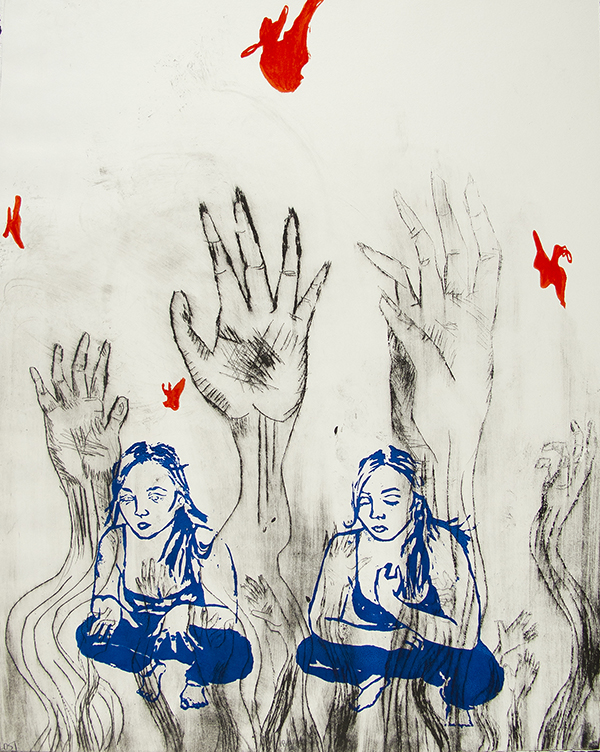
Jordan Vigil- Denver, Colorado, USA
Lost, 2020
Monotype and screenprint
Jordan Vigil is a BFA candidate in printmaking at the University of Colorado Boulder also pursuing a minor in Women and Gender Studies. Her work deals with ideas of intersectionality between gender, race, and class. She gives her perspective as a first-generation Latina student on the emotional and social challenges associated with these topics.
I created this piece Lost as a reflection of my indigenous identity; like indigenous women, my cultural heritage has been erased. Since the beginning of colonial conquest, Indigenous women have been the targets of violence, trafficking, and homicide and have seen no justice since. This piece was created to grieve the women the world lost, as well as my own inability to connect with my indigenous identity because it stopped being passed down before my generation.
In this print appears an image of myself squatting low to the ground signing (in ASL) "I'm lost" across varying backgrounds. From the bottom, arms and hands reach up and through my body as a representation of harm endured by native women, both past and present. Red dresses are flying through the air, as an allusion to the REDress Project by Jaime Black; each dress represents a lost/ missing indigenous woman. Printed lace thongs appear as symbols of the fetishization and sexual assault indigenous women suffered from colonizers. Color is important in the series: all prints contain red, white, and blue to directly confront the irony of celebrating nationalism in a stolen nation. The colors in the prints shift slowly to include less and less color to show the loss of souls, passions, and traditions along with the loss of indigenous people across a period of time, and if nothing changes, we'll all be lost in a nation that we can't claim.
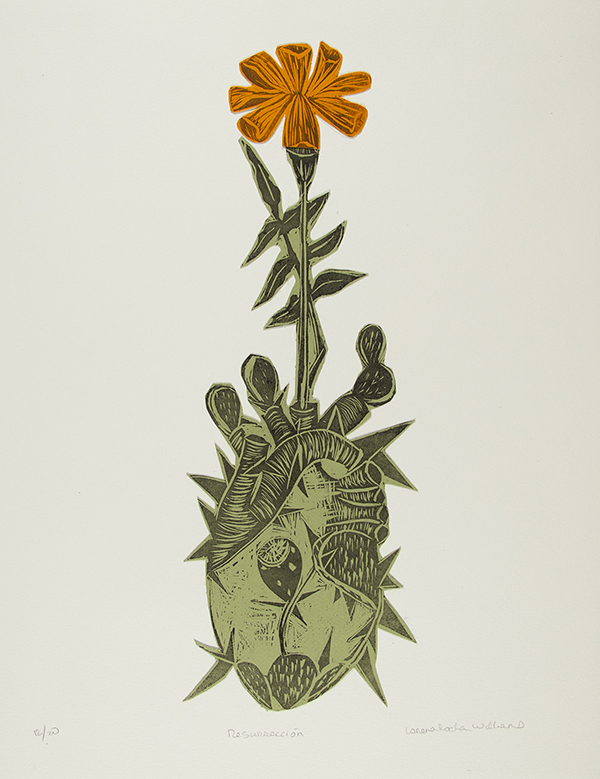
Lorena Williams- El Paso, Texas, USA
Resurrection, 2020
Relief and chine colle
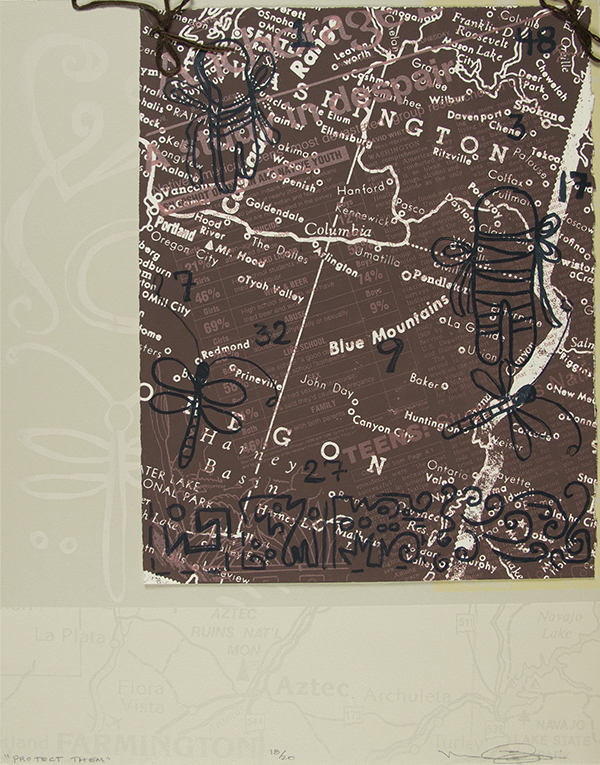
Melanie Yazzie-Boulder, Colorado, USA
Protect Them, 2020
Screenprint and thread
Melanie Yazzie is a Professor of Art and Head of Printmaking at the University of Colorado in Boulder, Colorado. Her works belong to many collections such as: the Anchorage Museum of History & Art, the Art Museum of Missoula, the Institute of American Indian Arts, the Kennedy Museum of Art and the Rhode Island School of Design Museum and many more. She has exhibited nationally and internationally in places such as: Alaska, California, New Mexico, New York, Florida, New Zealand, France, Russia, Canada, Estonia, Northern Ireland, Korea, China, South Africa, United Kingdom, Australia, and Argentina.
Protect Them
So many people go missing and are taken from us without us knowing why. There are so many layers to this problem. The newspaper story in my print gives statistics from 1993 but these same issues still exist in many communities to this day. It is due to these issues that there is self-doubt and a need to search or run away from home that leads many of these people in the hands of others who will harm them. I feel that knowing all these levels could help us see the problems that exist and try to begin to see why these problems persist. There are no answers here but there are some reasons the problems are present. So much of this is not looked at or even spoken of. We need to see the truth and listen when the time comes. Believe in the story that they share with us. Believing, Listening, and Supporting them is huge. The pain is triple when people do not believe the experience of these people from our human communities who are trying to share their truth. Look around and help in the world when you can. Believe in change by acting in ways that make change possible.
-
Tuesday - Friday
10:00AM - 5:00PMSaturday
1:00PM - 5:00PM